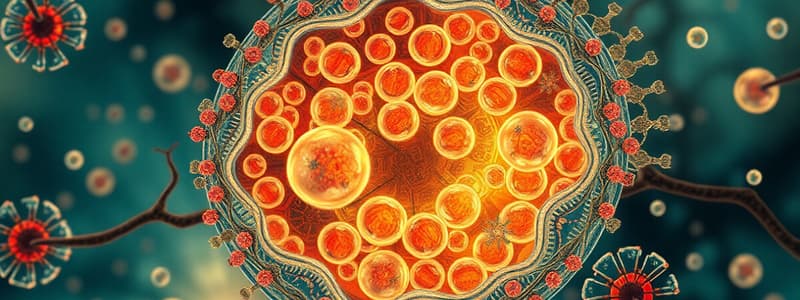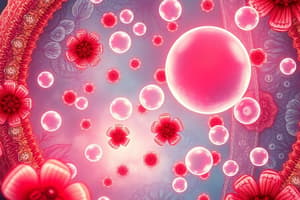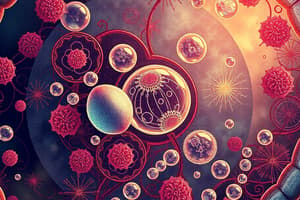Podcast
Questions and Answers
What is the primary function of mitochondria in the cell?
What is the primary function of mitochondria in the cell?
- Cell division
- ATP synthesis (correct)
- Protein synthesis
- Waste removal
What is the folded internal membrane of mitochondria called?
What is the folded internal membrane of mitochondria called?
- Cristae (correct)
- Matrix
- Cytoplasm
- Outer membrane
In what part of the mitochondria does the citric acid cycle occur?
In what part of the mitochondria does the citric acid cycle occur?
- Matrix (correct)
- Cytoplasm
- Outer membrane
- Cristae
Which process generates the most ATP during aerobic respiration?
Which process generates the most ATP during aerobic respiration?
What type of protein forms the smallest elements of the cytoskeleton?
What type of protein forms the smallest elements of the cytoskeleton?
Which cytoskeletal element is known for its strength and durability?
Which cytoskeletal element is known for its strength and durability?
What is the diameter range of intermediate filaments?
What is the diameter range of intermediate filaments?
What characterizes membranous organelles?
What characterizes membranous organelles?
From where do microtubules extend in the cell?
From where do microtubules extend in the cell?
Which of the following is a non-membranous organelle?
Which of the following is a non-membranous organelle?
What is the primary structure of the plasma membrane?
What is the primary structure of the plasma membrane?
Integral proteins in the plasma membrane are primarily responsible for which function?
Integral proteins in the plasma membrane are primarily responsible for which function?
Which statement about peripheral proteins is true?
Which statement about peripheral proteins is true?
What role do anchoring proteins play in the plasma membrane?
What role do anchoring proteins play in the plasma membrane?
What function do recognition proteins serve in the plasma membrane?
What function do recognition proteins serve in the plasma membrane?
What distinguishes transmembrane proteins from other integral proteins?
What distinguishes transmembrane proteins from other integral proteins?
What is the role of a solvent in a solution?
What is the role of a solvent in a solution?
Which of the following is NOT a factor influencing diffusion rates?
Which of the following is NOT a factor influencing diffusion rates?
What occurs during facilitated diffusion?
What occurs during facilitated diffusion?
How does osmotic pressure affect the movement of pure water?
How does osmotic pressure affect the movement of pure water?
What is the primary characteristic of an isotonic solution?
What is the primary characteristic of an isotonic solution?
What happens to animal cells in a hypertonic solution?
What happens to animal cells in a hypertonic solution?
What is the difference between osmolarity and tonicity?
What is the difference between osmolarity and tonicity?
Which process described requires the input of energy?
Which process described requires the input of energy?
What structural arrangement is found in cilia?
What structural arrangement is found in cilia?
Which structure is responsible for the synthesis of proteins?
Which structure is responsible for the synthesis of proteins?
What is the primary function of the nucleus?
What is the primary function of the nucleus?
What are microvilli used for in a cell?
What are microvilli used for in a cell?
What is the nuclear envelope?
What is the nuclear envelope?
Which of the following statements about centrioles is true?
Which of the following statements about centrioles is true?
How do nuclear pores function?
How do nuclear pores function?
Which of the following correctly describes triplets in microtubules?
Which of the following correctly describes triplets in microtubules?
What occurs during translocation in protein synthesis?
What occurs during translocation in protein synthesis?
What does the stop codon signify during elongation?
What does the stop codon signify during elongation?
Which phase of the cell cycle involves DNA replication?
Which phase of the cell cycle involves DNA replication?
What role does helicase play during DNA replication?
What role does helicase play during DNA replication?
In which stage of the cell cycle do cells prepare for division by making necessary proteins?
In which stage of the cell cycle do cells prepare for division by making necessary proteins?
What is produced from the lagging strand during DNA replication?
What is produced from the lagging strand during DNA replication?
What is the outcome of semi-conservative replication?
What is the outcome of semi-conservative replication?
What occurs during prophase in mitosis?
What occurs during prophase in mitosis?
Study Notes
Organelles
- Two types of organelles: membranous and non-membranous
- Membranous Organelles: enclosed by a phospholipid membrane
- Examples: mitochondria, nucleus, endoplasmic reticulum, Golgi apparatus, lysosomes, and peroxisomes
- Non-Membranous Organelles: not enclosed by a membrane, components are in direct contact with the cytosol
- Examples: cytoskeleton, centrioles, microvilli, cilia, flagella, and ribosomes
Cell Membrane
- Forms a barrier between the cell and its environment
- Consists of a phospholipid bilayer with scattered proteins
- Phospholipid Bilayer:
- Thin and delicate (6-10 nm)
- Hydrophilic heads face outward, hydrophobic tails face inward
- Creates a barrier between the cytoplasm and extracellular fluid
- Proteins:
- Integral Proteins: embedded in the membrane, pass all the way through (transmembrane proteins), can form channels or pores
- Peripheral Proteins: bound to the inner or outer surface of the membrane, easily separated
- Functional Classes of Membrane Proteins:
- Anchoring Proteins: connect the plasma membrane to other structures
- Recognition Proteins: recognized by cells of the immune system
- Receptor Proteins: bind to specific extracellular molecules (ligands)
- Phospholipid Bilayer:
- Diffusion: movement of molecules from an area of high concentration to low concentration
- Factors Influencing Diffusion Rate: distance, molecule size, temperature, gradient size, electrical forces
- Facilitated Diffusion: transport of large molecules with the help of carrier proteins (no ATP required)
- Osmosis: diffusion of water across a selectively permeable membrane from an area of high water concentration to low concentration
- Osmotic Pressure: force with which pure water moves into a solution due to solute concentration
- Osmolarity: solute concentration of a solution
- Tonicity: effect of a solution on a cell
- Isotonic: equal solute concentration inside and outside the cell (no net movement)
- Hypertonic: higher solute concentration outside the cell (water moves out, cell shrinks)
- Hypotonic: lower solute concentration outside the cell (water moves in, cell swells)
- Filtration: bulk flow of substances driven by a pressure gradient (no ATP required)
- Active Processes: require energy (ATP)
Mitochondria
- Powerhouses of the cell
- Responsible for ATP synthesis
- Double-layered membrane
- Cristae: folded inner membrane, increases surface area for ATP production
- Matrix: liquid enclosed by the inner membrane
- Aerobic Respiration: multi-step process for ATP production
- Glycolysis: glucose breakdown into pyruvate (occurs in cytoplasm, produces 2 ATP)
- Citric Acid Cycle: pyruvate breakdown into carbon dioxide, hydrogen, and 2 ATP (occurs in mitochondrial matrix)
- Electron Transport System: hydrogen atoms used to create 32 ATP, oxygen combines with hydrogen to form water
Cytoskeleton
- Provides internal framework, strength, and flexibility
- Composed of microfilaments, intermediate filaments, and microtubules
- Microfilaments: smallest, primarily composed of actin, found in the cell periphery
- Intermediate Filaments: strong and durable, various protein types, present throughout the cytoplasm
- Microtubules: largest, extend from the centrosome, involved in cell division
Centrioles
- Cylindrical structures composed of microtubules arranged in nine triplets
- Located at the centrosome
- Involved in cell division, forming spindle fibers that move chromosomes to the poles
Cilia
- Long, slender extensions for propelling fluids or solids
- Microtubules arranged in nine doublets around a central pair
Microvilli
- Finger-shaped extensions of the plasma membrane
- Core of microfilaments for stiffness
- Increase surface area for nutrient absorption
Ribosomes
- Responsible for protein synthesis
- Consist of two subunits: small and large
- Attached to the endoplasmic reticulum
Nucleus
- Control center of the cell
- Contains genetic information (DNA)
- Directs protein synthesis
- Usually the largest and most prominent structure in the cell
- Nuclear Envelope: surrounds the nucleus, double membrane with pores
- Nuclear Pores: allow communication between the nucleus and cytoplasm
DNA Replication
- Process of duplicating DNA
- Occurs during the S-phase of the cell cycle
- Steps:
- Helicase: unwinds and unzips the DNA
- DNA Polymerase: adds complementary nucleotides to create two daughter strands
- Lagging Strand: synthesized discontinuously, forming Okazaki fragments that are glued together by Ligase
- Leading Strand: synthesized continuously
- Semi-Conservative Replication: each daughter strand has one original and one new strand
- Sister Chromatids: two identical strands of DNA connected at the centromere
- Kinetochore: raised region on the centromere where spindle fibers attach
Cell Cycle
- Cycle of growth and division
- Interphase:
- G1: cell growth, normal functions, organelle duplication
- S: DNA replication
- G2: preparation for division
- G0: a resting state where cells permanently stop dividing
- M Phase: mitosis and cytokinesis
- Mitosis: identical nuclear division in somatic cells (body cells), for repair and replacement
- Prophase: nuclear membrane breaks down, chromosomes condense, spindle fibers form
- Metaphase: chromosomes line up at the equator of the cell, attached to spindle fibers at the kinetochore
- Anaphase: sister chromatids separate and move to opposite poles
- Telophase: nuclear membrane reforms, chromosomes decondense, cytokinesis begins
- Meiosis: nuclear division in sex cells (gametes), resulting in genetically diverse daughter cells
Protein Synthesis
- Steps:
- Transcription: DNA is copied into mRNA
- Translation: mRNA is translated into a polypeptide chain by ribosomes
- mRNA: messenger RNA, carries the genetic code from DNA to ribosomes
- tRNA: transfer RNA, carries amino acids to the ribosomes
- Ribosome: reads mRNA and assembles amino acids into a polypeptide
- Codon: three-nucleotide sequence on mRNA that specifies an amino acid
- Anticodon: three-nucleotide sequence on tRNA that complements a codon
- Elongation: process of adding amino acids to the polypeptide chain
- Translocation: shift of tRNA from one site on the ribosome to another
- Chain Termination: stop codon signals the ending of polypeptide synthesis
- Polypeptide Folding: polypeptide chain folds into a specific three-dimensional shape to become a functional protein
- Protein Structure: primary, secondary, tertiary, and quaternary
Studying That Suits You
Use AI to generate personalized quizzes and flashcards to suit your learning preferences.
Related Documents
Description
Test your knowledge on the various types of organelles, including membranous and non-membranous structures. This quiz also covers the essential functions and composition of the cell membrane, highlighting its importance in cellular processes. Brush up on your biology concepts!




